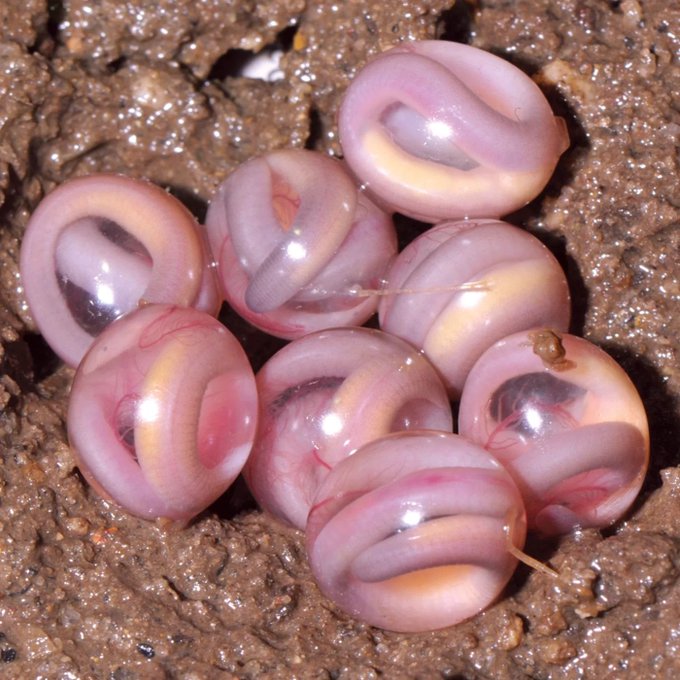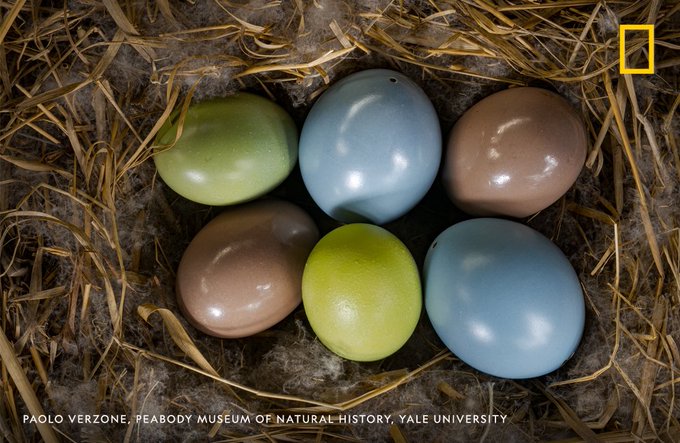Most Unique Eggs In The World

June 24, 2024
•20 min read
Let's explore the most unusual eggs in the world!
In 2022, over 100 billion chicken eggs were produced in the U.S alone! It’s fair to say that eggs have become part and parcel of everyday life for most of us. However, there are some eggs out there that you probably didn’t even know existed! From mesmerizing marbles, to ominous orbs, and even a clutch resembling some sort of hellish honeycomb, let's learn about the most unique eggs in the world!
Caecilian Eggs
With their long, thin, slimy bodies, caecilians look like the cursed siblings of snakes. However, turns out that those guys are actually limbless amphibians. One thing they do have in common with snakes though, is the distinctive eggs they produce. Most caecilians are viviparous, meaning they give birth to live offspring.
However, around 25% of species are oviparous, or egg-laying. But the eggs they do lay are like nothing you’ve ever seen or known before! The eggs of a chikilidae; a species of caecilian found in India, look like ultra-rare marbles.Pretty glass marbles? Nope! These are the eggs of Chikilidae, a family of Indian caecilians. They are legless amphibians, and they hatch from their eggs fully grown and ready to face the world! 📷: SD Biju, Amphibians of India

Harrowing as that process sounds, brooding mother’s skin cells are filled with fats, specifically developed to help her young grow big and strong! In one species, caecilian hatchlings that feasted on it's mother increased their mass by 86% in just 20 days!
Colorful Tinamou Eggs
As you already might know, Tinamous are plump, ground-dwelling birds that can be found in central and south America. Unlike most birds, which lay white or beige eggs, the tinamou lay their eggs in a wonderful variety of different colors, ranging from purple to pink, green to blue to brown!
Bird eggs, such as these from tinamous, get their colors from pigments including protoporphyrin and biliverdin. Some fossil dinosaur eggs preserve these two compounds hinting at their hues.

Largest Eggs
Measuring a massive 6 inches long and weighing in at 3 pounds, the ostrich produces the largest egg of any living animal! But if you think that’s supersized, feast your eyes on the enormous egg of the Elephant Bird; a now-extinct creature that once roamed the jungles of Madagascar.

It’s believed that there may be as few as 25 perfectly preserved elephant eggs in existence. Thanks to their rarity and supersize, those things sell for a pretty penny. In a 2013 London auction, an elephant bird egg sold for over $100,000! For some perspective, if you were looking to make that much cash with chicken eggs, you’d need to sell almost 300,000 of them!
Smallest Eggs
From the massive to the miniscule, our next most unique egg comes from the bee hummingbird, the world’s smallest living bird. So teeny-tiny that flier is, that they’re around the same size as a bumblebee, hence their name.
In all, they grow to be just over 2 inches long, while they weigh less than 0.1 ounces! For reference, that’s about as heavy as a dime! But if you thought adults were small, wait until you see their eggs!For starters, their nest is only about 1 inch wide, while the egg itself has a diameter of just 0.33 inches, making it the same size as a coffee bean. Weighing in at just 0.03 ounces, that lil thing is about as heavy as one single raisin!Sea Urchin Eggs
If you thought bee hummingbird eggs were small, then buckle up, because you haven't seen anything yet! Across the world’s oceans, sea urchins, a globular hard shelled, spikey cousin of the starfish, mostly reproduce through a method known as broadcast spawning.
That involves the separate release of both eggs and sperm into a water column from females and males respectively, with fertilization occurring externally when the egg and sperm make contact. In all, female urchins may release as many as 2 million eggs into the sea, each!Pearly Orbs Covering Argentina Beaches
Sea urchins aren’t the only ocean critter to produce some pretty puzzling eggs. In 2021, visitors to the Mar del Plata beach in Argentina were greeted by the sinister site of thousands of strange squidgy orbs covering the shore.
Fortunately, it turns out that those are in fact the eggs of an earth-based animal; the Adelomelon brasiliana. The eggs of that species of sea snail have a firm, transparent shell, filled with a thick gelatinous liquid that helps protect the embryos until they hatch.Shark Eggs
Turns out that rotting alien eggs aren’t the only thing that you need to watch out for when taking a leisurely stroll on the beach. If you ever stumble across our next unique and obscure egg, you might think that you’ve just discovered Poseidon’s corkscrew.
But that spirally substance is actually the product of a sea-dwelling critter. Bullhead sharks, found in the warm waters of the Indian and Pacific Oceans, are culpable for creating those terrific twirling eggs.But why are they not egg shaped? To put it simply, after mama shark lays her spiral egg, she carries it around in her mouth. Thanks to its twisted design, the egg can be wedged between rocks in hard to reach places, preventing predators from snacking on it.
Ethereal Goosefish Eggs
Back in 2016, a fisherman by the name of Edward Mortell made a strange discovery at sea. There was a large, dark shroud floating on the water’s surface, moving with the waves. Turns out the curious cloud that Mortell spotted was actually a buoyant veil, containing goosefish eggs.

Common Murre Eggs
Flying high above goosefish veils, you might spot a Common Murre, a seabird distributed around the North Atlantic and Pacific oceans. During breeding season, those black and white birds lay eggs on rocky cliffs that overhang the sea.
If that doesn’t sound daredevilish enough, those fearless fowl don’t even create a nest for their eggs. Instead they just let them rest on a perilous perch, several hundred feet above the waves!However, those bright birds have a terrific trick up their wing to help their young. Common murres don’t lay ordinary ovular eggs. Instead, they’re pyriform, meaning they’re pointed at one end, like a pear.Okarito Kiwi Eggs
For humans, carrying an average 7lb baby to term has to be one of the most back-breaking experiences ever and that’s before pushing it out. But as agonizing as that sounds, it pales in comparison to what Okarito Kiwi mamas go through.
Typically, those flightless birds, found in New Zealand, lay an egg weighing almost 1 pound, about the same as a soccer ball. But female Okarito kiwis only weigh about 4 ½ pounds themselves, meaning the egg’s weigh more than a staggering 20% of their body mass!
Proportionally, that makes it the largest of any bird. The enormous egg plumps up pregnant females so much that their bulged bellies can drag along the ground. For some idea of just how great that feat is, ostriches lay eggs that weigh around 3 pounds. Yet, the big birds themselves weigh around 220 pounds, meaning the egg takes up just over 1% of the mother’s mass.
Fortunately for the defiant kiwi mamas, the struggle is for a good cause. The giant egg means that kiwi chicks have more room to fully develop, so when they hatch, they’re ready to run almost immediately!Ayam Cemani Hatching Eggs
In the depths of Indonesia, there exists a creature that’s completely black: from its feathers, to its organs, and even its bones! You may think I’m describing some sort of mythological beast, but those are in fact the features of the Ayam Cemani, a rare breed of jet-black chicken.
While it may look like those guys have been dipped head to tail in dark paint, the reason for their color is actually down to fibromelanosis. That genetic condition causes an excessive production of melanin; the pigment that gives color to skin, hair, eyes just about everything in the body!As a result, that turns pretty much everything associated with the Ayam Cemani black. Well, not quite everything. Surprising as it may sound, the eggs of those birds are cream-colored. Still, many people often presume that those black birds produce dark eggs.Yet, despite their standard looks, Ayam Cemani eggs still sell for a hefty fee. Fertile eggs can cost $160 per dozen, making them almost 40 times more expensive than your standard chicken eggs.Apple Snail Eggs
From the inky to the illuminous, our next batch of animal eggs are sure to strain your eyes. Introducing the apple snail, a species of freshwater snail, native to South America. While the snails themselves don’t look too appetizing, the same can’t be said for their eggs!
At first glance they look like some sort of super succulent raspberries growing in some super strange positions, but they’re actually broods of apple snail eggs! Not a mistake you want to make.
Cane Toads
Anyone familiar with Cane Toads knows those aren’t animals that you want to get too familiar with! The skin-gland secretions of those awful amphibians contain bufotoxin; a toxic compound that’s so potent, that in the right dose it can kill animals that attempt to feed on those creatures.
Spotted Salamanders
Just like their creepy cane toad cousins, Spotted Salamanders, found in the U.S encase their spawn in a gooey gelatinous coating. But instead of long, thin, ropes of eggs, salamanders produce something that has to be seen to be believed. They lay some kidney-shaped masses, each containing up to 250 individual eggs.

Not only does that relationship help the salamander embryos grow, it also turns the eggs within the mass bright green! So, if you happen to stumble upon a swampland filled with those bizarre, bright green blobs, rest assured that you’re looking at salamander spawn, not evidence of extraterrestrial life!
Brown Marmorated Stink Bug
On the topic of aliens, that brings us onto the Brown Marmorated Stink Bug. Those dark brown insects, found in Asia, Europe, and the Americas, may not look too crazy as adults, but the same can’t be said for their creepy clutch.
African Rock Python
Whether it’s their unquenchable appetite for large animals, or fearsome 15-foot length, Central African Rock Pythons aren’t critters you want to stumble across. Yet, that’s exactly what happened to locals in a Nigerian village, back in 2016.
However, that was no normal snake. That beastie was bulging at the sides. So much so that the villagers believed it’d chowed down on a calf or a person! Concerned, they decided they had to look for themselves.Indochinese Cobra
Around 70% of all snake species lay eggs, yet few are more peculiar than the Indochinese cobra; a serpent found in Southeast Asia. Females of that species lay around 16 ovular eggs, only a few inches in length, which hatch after about 2 months. They look normal enough, but the wonder around those things comes on hatching day.
Unfortunately for the snakelets, their parents don’t stick around for the special occasion. In fact, Indochinese cobra babies are completely independent as soon as they hatch. Seems pretty likely that they’d get snacked on by a predator, right? But luckily the hatchlings have it covered. As soon as they hatch, those babies can straighten up right away. That move increases their size, warning any predators to back off! If that wasn’t intimidating enough, those bold babies also come armed with a toxic supply of fully developed venom, that’s stored through a small hole in their bottom fangs.Wheel Bug Cylindrical Eggs
With their piercing beak, slender appendages, and creepy cog-shaped crest, Wheel Bugs are an insect that look like they crawled out of the dark pits of hell. Yet, spine-chilling as those bugs look as adults, they’re nothing compared to their own eggs.





















